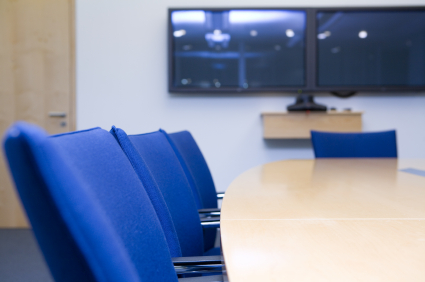One of the major issues with videoconferencing deployment is understanding that there are more factors in play than just the video conferencing hardware. If you fail to recognize these details, the system will still work but wont be up to its potential.
Telepresence is an industry buzzword equating to the optimal lifelike videoconferencing system. We can learn a lot about what makes up a good video call by observing some key elements found in these high end systems. Since the goal of videoconferencing is ultimately to provide a way to communicate effectively across locations, I feel that it is important to optimize the experience as much as budget allows.
Speaker Location
When talking in person with someone across the room from you, the sound of their voice comes from their direction. If you were hearing their voice coming from above or even behind you, it would be distracting to say the least. This is what happens when you use ceiling speakers in a videoconferencing environment. The sound of someone talking should come from their perceived location, which means audio should be coming from the monitor or projection screen. This can be accomplished by speakers mounted just beside the display.
Microphones
Microphones operate under very strict acoustic principles. Simply put, a mic will pick up the sound that is closest to it. If this happens to be background noise, then overall speech ineligibility will be compromised. This is one of the challenges with ceiling microphones, which do work but only in controlled environments. Shure actually goes so far as to say something along the lines of “if you are going to use ceiling mics without considering the acoustics, please don’t use ours as it makes us look bad” (see article on Shure’s website)
Camera position
When you look someone in the eye, your videoconference system should help convey that and I have seen far too many installations with bad camera placement. Ideally your camera should be positioned at the display of the far end so that looking at the far end participants means you are looking directly at the camera. Having the camera up high and pointing down not only gives an unflattering view of people, it is extremely annoying to be talking to the tops of people’s heads.
Display Placement and Size
Going back to our telepresence model, the display size and placement are chosen to show the far end meeting participants in life-like size. While your system may not be engineered to that type of specification (or you are doing a classroom style distance learning system) you should still aim to show the far end as naturally as possible. To me, this means that if the display doesn’t HAVE to go in the corner of the room near the ceiling for example, don’t put it there. It will be more effective at a comfortable viewing height that facilitates a more natural conversation between sites. For a lot of deployments, display size is also dependant on factors such as viewing distance since the displays are often used for presentations as well as video conferencing.
Lighting
Far too often the buzz of high definition video conferencing surpasses this fundamental subject. For a camera to “see” you need to have adequate lighting and I feel this becomes more critical as we push high definition resolutions – people expect to see video calls with the same clarity as the news anchor on TV. A TV broadcast studio is the defiantly the optimium lighting for video broadcast, and most video conference systems will not require such detailed light placement. Lighting should at the bare minimum be designed in a way to at least give even coverage of the meeting participants and in some cases additional lights can be placed to improve key areas. If you have any insight into a reccomended illumination for a typical room (in lux) please leave a comment below and I will update this.
To summarize, we all know the expression “garbage in, garbage out”. This has been a high level review showing the importance and reasoning behind proper video conferencing design. Effective videoconferencing design will improve utilization which has a huge positive net effect on this aspect of our industry. With more demand, we will be able to deploy more systems enabling people all over the world to communicate without travel boundaries. After all, the goal is to help people communicate.
If you would like more technical based information on some of the topics touched on, or have some personal experience with some of these concepts, please leave a comment below.



